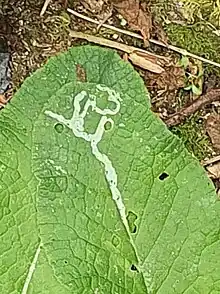Chromatomyia primulae
Chromatomyia primulae is a species of leaf-mining fly in the family Agromyzidae, of the order Diptera. The larvae mine the leaves of Primula species. The fly was described by the French physician and entomologist, Jean-Baptiste Robineau-Desvoidy in 1851 and is found in Europe.
| Chromatomyia primulae | |
|---|---|
 | |
| Scientific classification | |
| Domain: | Eukaryota |
| Kingdom: | Animalia |
| Phylum: | Arthropoda |
| Class: | Insecta |
| Order: | Diptera |
| Family: | Agromyzidae |
| Genus: | Chromatomyia |
| Species: | C. primulae |
| Binomial name | |
| Chromatomyia primulae (Robineau-Desvoidy, 1851)[1] | |
Life history
Mines are white, long and narrow, with the frass in widely spaced black lumps. Larvae can be found in June and August-September. Mines have been recorded in the following plants: Primula bullesiana, oxlip (Primula elatior), Primula uralensis, cowslip (Primula veris) and primrose (Primula vulgaris). Pupation is within the mine, next to a vein with the anterior spiracles projecting through the epidermis. Adults fly in July[2][3]
References
- "Chromatomyia primulae (Robineau-Desvoidy, 1851)". Fauna Europaea. Retrieved 24 June 2023.
- "Chromatomyia primulae (Robineau-Desvoidy, 1851)". UKflymines. Retrieved 25 June 2023.
- Ellis, W N. "Chromatomyia primulae (Robineau-Desvoidy, 1851)". Plant Parasites of Europe. Retrieved 25 June 2023.
This article is issued from Wikipedia. The text is licensed under Creative Commons - Attribution - Sharealike. Additional terms may apply for the media files.